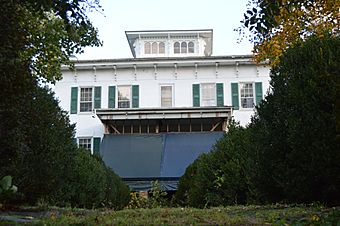Blandome facts for kids
|
Blandome
|
|

Northern side
|
|
| Location | 101 Tucker St., Lexington, Virginia |
|---|---|
| Area | 1.9 acres (0.77 ha) |
| Built | c. 1830, 1872 |
| Architectural style | Federal, Greek Revival, Italianate |
| NRHP reference No. | 01001520 |
Quick facts for kids Significant dates |
|
| Added to NRHP | January 24, 2002 |
Blandome is an old house on a hill in Lexington, Virginia. It was built around 1830. This house has seen many changes in Virginia's history. Different families have lived here. Its story shows how society and race relations in Virginia changed over time.
Contents
History of Blandome: A Home Through Time
Blandome was built around 1830. We don't know exactly who built it. The first clear records for this area, called "Diamond Hill," start around 1872. That's when Laura H. Tucker bought the house. She was the wife of John Randolph Tucker. They bought it for $6,500 from Jacob Fuller. He was a librarian at the Virginia Military Institute (VMI).
Early Years and the Civil War Era
John Thomas Lewis Preston lived at Blandome in the 1830s. He was a very important person in starting VMI. His son, Thomas Lewis Preston, was born here in 1835. John T. L. Preston later moved his family to another house. He was a teacher, lawyer, and military officer. He helped found VMI in 1839. He was one of its first professors.
Preston served in the Confederate States Army during the American Civil War. After the war, he faced money problems. He returned to teach at VMI. In 1870, he transferred some property to Jacob Fuller. Preston and Fuller were also business partners. They invested in a tannery together. Another VMI professor, Stonewall Jackson, was also an investor.
The Fuller family lived in Blandome in the 1850s. Jacob Fuller ran a school in Lexington. During the Civil War, Union General George Crook used the Fullers' house as his headquarters. Jacob Fuller later sold other houses on the street. He built a smaller house for himself nearby.
The Tucker Family's Time at Blandome
John Randolph and Laura Tucker bought Blandome in 1872. They gave the house its name. They also made many updates to it. John Randolph Tucker was a lawyer. He was Virginia's Attorney General during the Civil War. He supported the Confederate cause.
After the war, he defended Jefferson Davis, the Confederate President. He also taught law at the University of Virginia. In 1870, Robert E. Lee invited Tucker to teach at Washington College. This college later became Washington and Lee University. The Tuckers lived at Blandome from 1872 to 1875. John Randolph Tucker became the first dean of the new law school there.
Tucker then became a representative in the United States House of Representatives. He represented Virginia's 6th district. He also kept a home and law office in Washington, D.C.. In 1889, he returned to Washington and Lee University. He taught law there again. He also continued his private law practice. He even built a small office building next to Blandome for his work. He became President of the American Bar Association. He passed away in 1897. His son, Harry Tucker, also worked at the Washington and Lee Law School. In 1904, Laura Tucker sold Blandome.
The Walker and Wood Families in the 20th Century
After a few other owners, an African American business leader named Harry Lee Walker bought Blandome. This was in the early 1900s. Harry Lee Walker was born nearby. He started as a butcher. He built a very successful business. He sold meat, seafood, and groceries. He also made money by investing in real estate.
His wife was Eliza Bannister Walker. She was a nurse and a singer. They were very active in their church. Eliza supported many social and educational causes. She especially helped black people, women, and children. Their daughter, Nannie Elizabeth, married Clarence M. Wood Sr. He became Harry Lee Walker's business partner. Eliza Walker helped start the Virginia Federation of Colored Women. They held their 1921 meeting at Blandome.
Clarence M. Wood Sr. continued his father-in-law's businesses. He and Nannie raised six children at Blandome. Clarence was from Middlesex County, Virginia. He graduated from Virginia Union University. He edited the Lexington Star newspaper. He also sold real estate and insurance. In the 1930s, he taught night school. In the 1940s, he managed the Green Pastures Recreation Area. This area was for black people only at the time. Wood also owned a car dealership, a gas station, and an ice cream parlor. He passed away in 1957.
His wife, Nannie, managed the family businesses after he died. She did this until her own death in 1993. One of their sons, Alexander B. Wood, moved into Blandome in 1997. He lived there with his wife, Freddye H. Wood. They continued the family's involvement in the community. They also made important updates to the house.
Blandome's Architecture and Design
Blandome was built around 1830. It is a two-story brick house. It has five sections across the front. Its style mixes Federal and Greek Revival designs. In 1872, it was updated in the Italianate style.
The house has a metal roof that slopes inward. A small tower called a belvedere sits on top. There is a front porch with three sections. The front door has beautiful decorations around it.
Other buildings on the property are also important. There is a seven-sided law office building from around 1890. There is also a garage from about 1950. An old ice chest from around 1920 is also on the property.
Blandome was added to the National Register of Historic Places in 2002. This means it is a special historical site.
Images for kids




